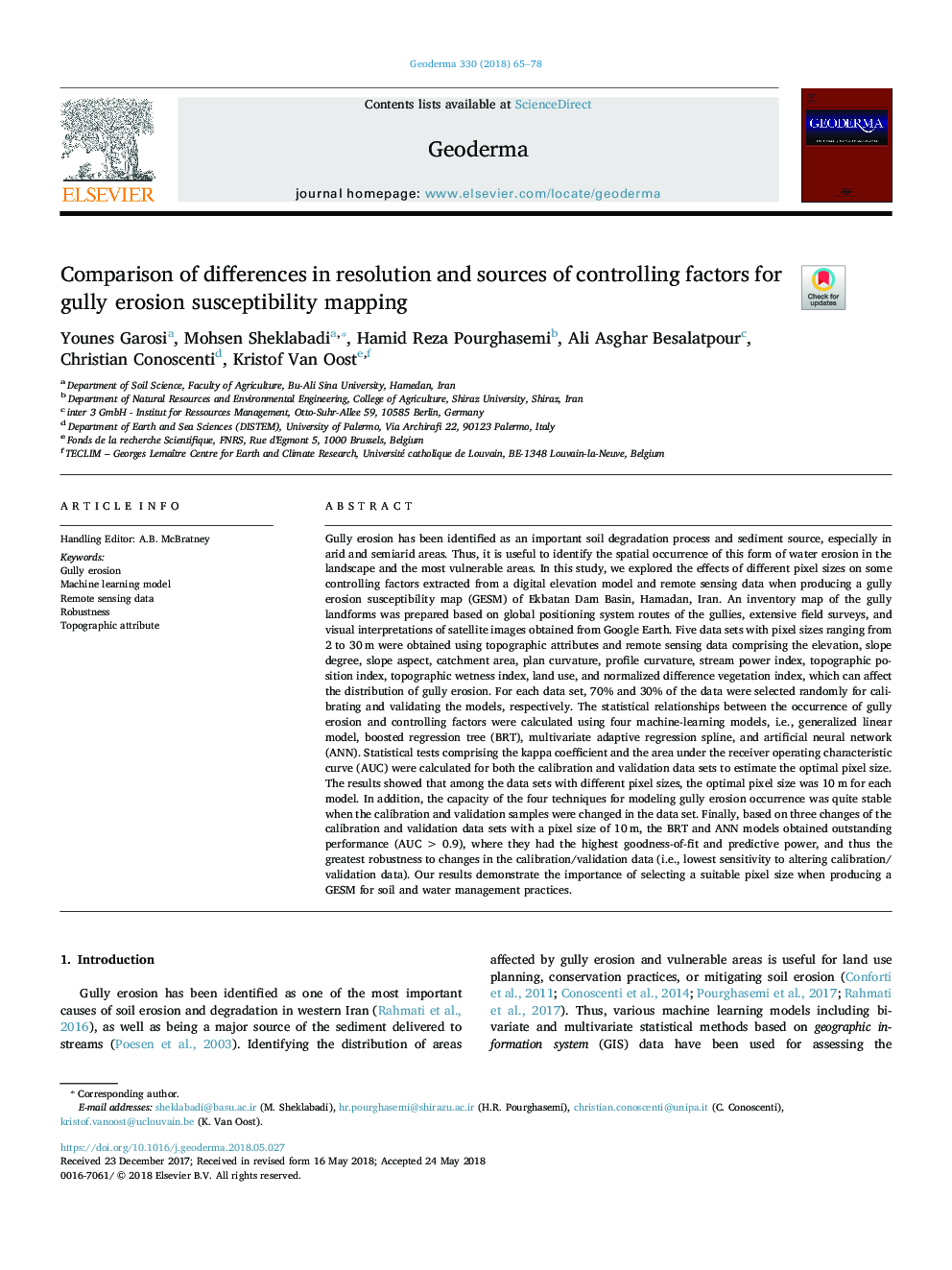| کد مقاله | کد نشریه | سال انتشار | مقاله انگلیسی | نسخه تمام متن |
|---|---|---|---|---|
| 8893906 | 1629387 | 2018 | 14 صفحه PDF | دانلود رایگان |
عنوان انگلیسی مقاله ISI
Comparison of differences in resolution and sources of controlling factors for gully erosion susceptibility mapping
ترجمه فارسی عنوان
مقایسه تفاوتهای تفصیلی در قطعنامه و منابع عوامل کنترلکننده نقشهبرداری حساسیت فرسایش
دانلود مقاله + سفارش ترجمه
دانلود مقاله ISI انگلیسی
رایگان برای ایرانیان
کلمات کلیدی
فرسایش کوهی، مدل یادگیری ماشین، داده سنجش از راه دور، نیرومندی، ویژگی توپوگرافی،
موضوعات مرتبط
مهندسی و علوم پایه
علوم زمین و سیارات
فرآیندهای سطح زمین
چکیده انگلیسی
Gully erosion has been identified as an important soil degradation process and sediment source, especially in arid and semiarid areas. Thus, it is useful to identify the spatial occurrence of this form of water erosion in the landscape and the most vulnerable areas. In this study, we explored the effects of different pixel sizes on some controlling factors extracted from a digital elevation model and remote sensing data when producing a gully erosion susceptibility map (GESM) of Ekbatan Dam Basin, Hamadan, Iran. An inventory map of the gully landforms was prepared based on global positioning system routes of the gullies, extensive field surveys, and visual interpretations of satellite images obtained from Google Earth. Five data sets with pixel sizes ranging from 2 to 30â¯m were obtained using topographic attributes and remote sensing data comprising the elevation, slope degree, slope aspect, catchment area, plan curvature, profile curvature, stream power index, topographic position index, topographic wetness index, land use, and normalized difference vegetation index, which can affect the distribution of gully erosion. For each data set, 70% and 30% of the data were selected randomly for calibrating and validating the models, respectively. The statistical relationships between the occurrence of gully erosion and controlling factors were calculated using four machine-learning models, i.e., generalized linear model, boosted regression tree (BRT), multivariate adaptive regression spline, and artificial neural network (ANN). Statistical tests comprising the kappa coefficient and the area under the receiver operating characteristic curve (AUC) were calculated for both the calibration and validation data sets to estimate the optimal pixel size. The results showed that among the data sets with different pixel sizes, the optimal pixel size was 10â¯m for each model. In addition, the capacity of the four techniques for modeling gully erosion occurrence was quite stable when the calibration and validation samples were changed in the data set. Finally, based on three changes of the calibration and validation data sets with a pixel size of 10â¯m, the BRT and ANN models obtained outstanding performance (AUCâ¯>â¯0.9), where they had the highest goodness-of-fit and predictive power, and thus the greatest robustness to changes in the calibration/validation data (i.e., lowest sensitivity to altering calibration/validation data). Our results demonstrate the importance of selecting a suitable pixel size when producing a GESM for soil and water management practices.
ناشر
Database: Elsevier - ScienceDirect (ساینس دایرکت)
Journal: Geoderma - Volume 330, 15 November 2018, Pages 65-78
Journal: Geoderma - Volume 330, 15 November 2018, Pages 65-78
نویسندگان
Younes Garosi, Mohsen Sheklabadi, Hamid Reza Pourghasemi, Ali Asghar Besalatpour, Christian Conoscenti, Kristof Van Oost,
